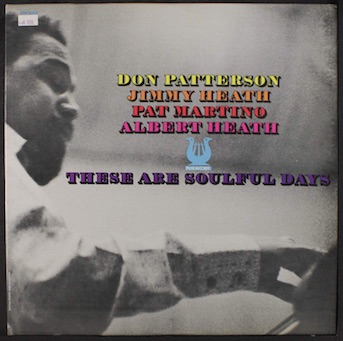










































































































































































|
Return to Homepage
SwingJournal #18
These Are Soulful Days
Artist : Don Patterson
Original Recorded Date : September 17, 1973
Original Label : Muse Records
Recorded Location : RCA Studios, New York
Producer : Don Schlitten
Engineer : Paul Goodman
These Are Soulful Days
Audio File
Download Sheet Music for Carl Massey’s “These Are Soulful Days“
Solo Cubano Tres Arrangement/Performance by Hideaki Tokunaga
Whistle While You Work :
There are three famous songs which are written for the Disney animation film “Snow White and the Seven Dwarfs”. They are “Someday my Prince Will Come”, “Heigh-Ho” and this composition ”Whistle While You Work”. The leader of this album is Don Patterson, one of the innovative organists after Jimmy Smith. Compared to many other organists in his era, he revealed more pianists influence on his performance. On this composition, you can hear a lot of Bud Powell influence. ”Whistle While You Work” is in the AABA form. Patterson plays the melody on A sections and tenor saxophonist Jimmy Heath plays melody on B section.
Patterson plays the first solo with swinging Albert Tootie Heath on drums. The second soloist is Pat Martino. By listening to Martino’s solo, you can immediately tell that Wes Montgomery strongly influenced Martino at this stage. Jimmy Heath appears as a last soloist. Tenor saxophonist Jimmy Heath is an older brother of drummer Albert “Tootie Heath” who appears on this recording. Tootie and Jimmy also have an older brother Percy Heath who is a hard core bassist from Modern Jazz Quartet. These three brothers are known to be “Heath Brothers”. Only two of them appear on this recording, because Patterson’s left hand replaces Percy’s walking bass. Similar to the head in melody, Patterson and Jimmy Heath alternate head-out melodies. At the end of composition, Jimmy returns to play unison lines with Patterson.
Skylark : Patterson takes care with cadenza, and guides Tootie and Martino to join. Jimmy lays out this composition and Patterson-Martino-Tootie trio can be heard. It maybe a small accident that Patterson didn’t tell what kind feel he wants to play. Therefore, Tootie starts playing with a swing feel, suddenly Patterson switches bass notes to keep steady quarter notes. Instead of slow ballad, the ensemble plays walking ballad.
Patterson generally retains his erstwhile idiomatic organ bluesy vocabularies. However he keeps the clear bebop melodic lines within his solos. Patterson also beautifully judges the spaces during his solo. Martino responds to Patterson’s space and Tootie’s brushes.
Blue ’n’ Boogie : Dizzy Gillespie’s composition Blue ’n’ Boogie is a fast tempo blues in the key of Bb. Some of jazz lovers may be familiar with Wes Montgomery’s live album called “Full House”. On that recording, Montgomery’s quintet swings so hard you can enjoy their version of “Blue ’n’ Boogie”. 10 years later from Montgomery’s “Full House”, this swing feel is passed down to Martino. The melodies are played by Martino and Jimmy Heath.
Martino plays the first solo and Jimmy plays the 2nd solo. Montgomery is known to be a thumb picker and Martino uses a pick to pluck strings. It is interesting to compare these two great guitarists by listening to the same compositions. You can also compare two great saxophonists. Johnny Griffin for Montgomery’s “Full House” and Jimmy Heath for this recording. You may think that Jimmy is more sophisticated than Griffin. But you can enjoy Jimmy’s bluesy phrases along with many Charlie Parker influenced vocabularies. Patterson is the third soloist and he may be struggling to keep up with this tempo by comping himself. Tootie also plays open 2 chorus drums solo to keep the energy flow to the head-out melodies.
Muse Blues
Unlike Blue ’n’ Boogie, this blues is much slower blues in the key of F. Tootie keeps the triplets while Patterson holds the laid back quarter bass lines. You can enjoy Patterson’s blues idiom on his solo. It is clear that Patterson received the biggest influence from the king of organists, Jimmy Smith. Compared to Smith, Patterson uses many bebop vocabularies such as diminished scales. After Patterson, Jimmy plays saxophone solo. In the middle of Jimmy’s solo, Tootie starts playing crazy triplets, then the ensemble starts treating this composition as a jazz waltz.
When Martino plays solos, the ensemble returns to slow blues with eighth triplets feel. In the middle of Martino’s solo, Tootie plays energetic long rolls on his snare drums, Martino continues with a really hot temperature.
When I listen to organists, I usually listen to many other factors; most importantly who is the drummer. From talking to many organists, their favorite drummers are often quite different from horn players’ favorite drummers. The well-known organists’ favorite drummers are Idris Muhammad (Leo Morris) and Donald Bailey. On the other hand, drummer Elvin Jones appears on both organ albums and hard-core straight ahead jazz albums. Unfortunately, it is rare to listen to Tootie Heath with many organists. By listening to this album, he should have played with more organists. The other factors are I always enjoy listening to the way guitarists comp organists’ solos and how organists comp guitarists’ solos. You can enjoy both Patterson’s and Martino’s accompaniment approaches on this recording.
|

|
If you like above CD, please try listed below products.
Nolan Shaheed
|
Akiko Tsuruga
|
Akira Jimbo
|
Marcus Shelby
|
Ruben Rada
|
Hugo Fattoruso
|
Dawan Muhammad
|
Phil Ranelin
|
Alan Barnes
|
|

|

